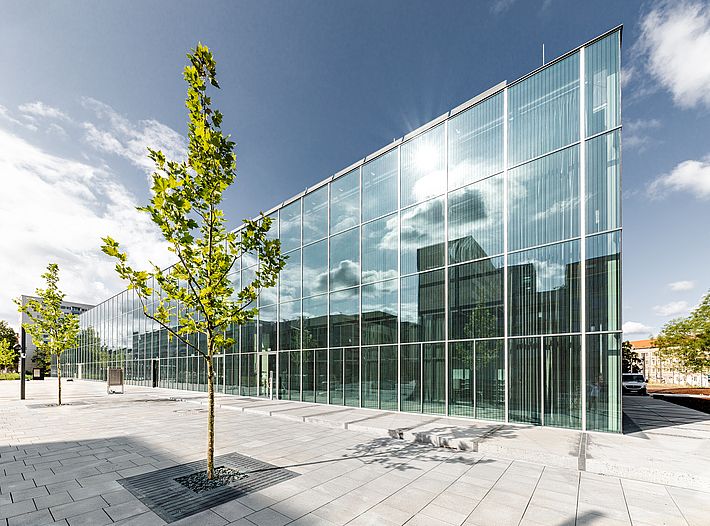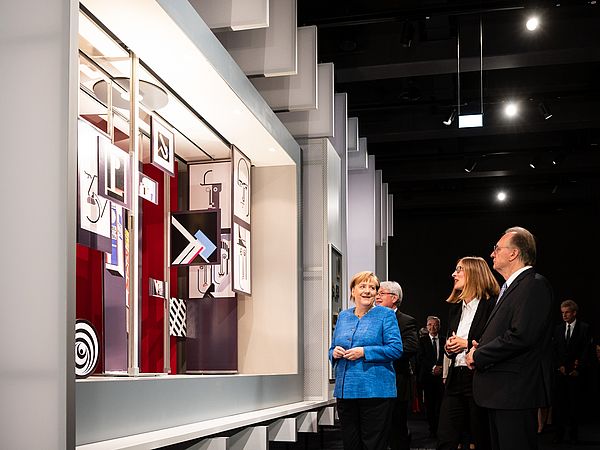Bauhaus Museum Dessau
The Bauhaus Museum Dessau was built for the centenary of the founding of the Bauhaus and open on September 8, 2019. So far, it has only been possible to present the prized collection of the Bauhaus Dessau Foundation in a limited way in the Bauhaus Building.

headline
In the new museum, a suitable space to publicly display the collection is being created for the very first time. The collection of the Bauhaus Dessau Foundation comprises around 49,000 catalogued exhibits and is the second-largest collection worldwide on the theme of the Bauhaus. The new museum will have an exhibition space of 2,100 square metres and a total usable area of 3,500 square metres.
On November 1, 1976, the “Galerie am Sachsenplatz” in Leipzig charged the City of Dessau-Roßlau with the amount of 145,000 Marks for 148 works of Bauhäusler. Ranging from ceramics to furniture, it was a colourful mix. The items were exhibited for the first time in the Bauhaus Building, which was re-opened as Scientific-Cultural Centre in the GDR on the 4th of December 1976 on the occasion of the 50th anniversary of the Bauhaus. This purchase formed the basis of the collection of the Bauhaus Dessau Foundation, now consisting of more than 49,000 items. This first convolute will welcome the visitors of the Bauhaus Museum Dessau on the occasion of the centenary of the Bauhaus’ foundation.
Headline
The exhibition at the Bauhaus Museum Dessau is titled “Versuchsstätte Bauhaus. The Collection.” It features over 1,000 exhibits and tells the story of the famous school in Dessau. It describes Bauhaus as a vibrant place where people taught and learned, conducted artistic experiments and worked on industrial prototypes.
With a total of about 49,000 objects, the Bauhaus Dessau Foundation’s collection is the second largest Bauhaus collection world-wide – and one of the newest: The first purchase was made in 1976 when the Bauhaus Building was reopened as “Wissenschaftlich-Kulturelles Zentrum” in the former GDR. Since then, new objects have regularly been added. Student works, teaching notes, drafts and prototypes from the workshops in particular define the character of the collection.

Contact
Bauhaus Museum Dessau
Mies-van-der-Rohe-Platz 1
(an der Kavalierstraße)
06844 Dessau-Roßlau
Opening hours
Tue – Sun, 10 am – 6 pm
T +49 (0)340 – 6508250
E service(at)bauhaus-dessau.de
Headline
For this reason, the exhibition “Versuchsstätte Bauhaus” does not focus primarily on the famed design icons and the masters, but rather the school and the students: the daily reality of learning and teaching between the poles of creative design and industrial prototype production, artistic experiment and economic pressure, educational institution and emancipatory aspiration. The individual thematic sections concentrate on the teaching concept and the instruction provided, on the Bauhaus as a versatile “testing ground”, as a partner that cooperated with industry, and as a bustling and imaginative communicator.
The exhibition derives the Bauhaus design ideas with which we are so familiar today from the historical context, and at the same time does not omit mentioning the crises and constraining factors under which the epoch-making school fought to survive. In a climate of political change and cultural uncertainty, the Bauhaus community, a world-wide network, questioned the customary conventions of teaching, coexistence and gender relations. Similarly, in Dessau the school did not receive unequivocal support, but also faced criticism. “Versuchsstätte Bauhaus” highlights the many conflicts involved in the tussle to ensure art and design gained social relevance.
For the exhibition “Versuchsstätte Bauhaus” in the “Black Box” of the Bauhaus Museum Dessau, curated by Regina Bittner, Dorothée Brill and Wolfgang Thöner, the Berlin office chezweitz developed a scenography of changing modes of showing. It makes the complexity of the Bauhaus school a spatial experience.